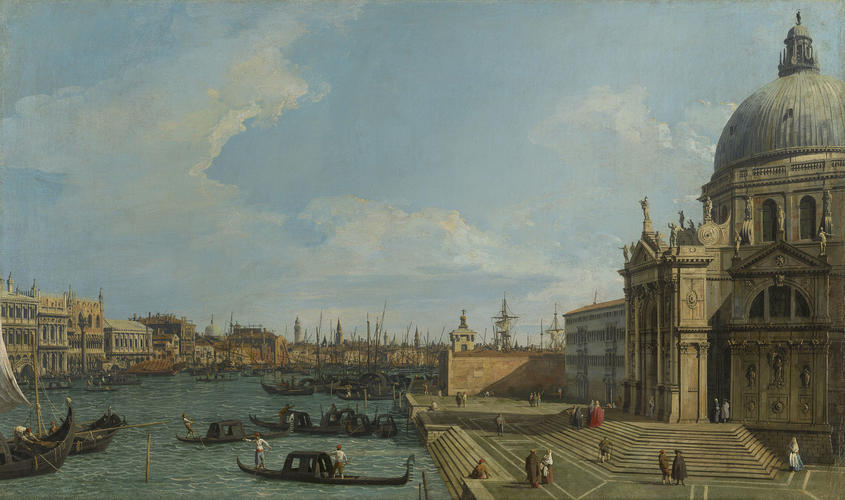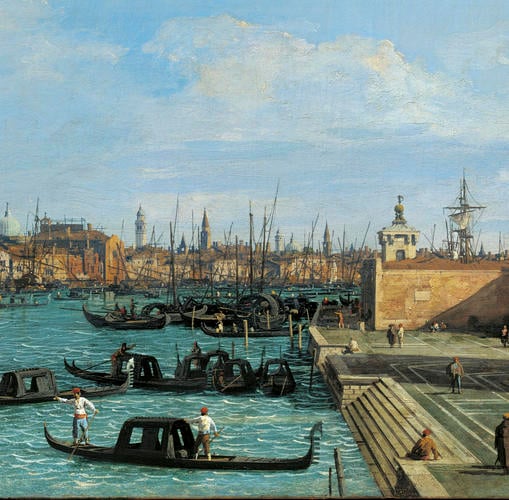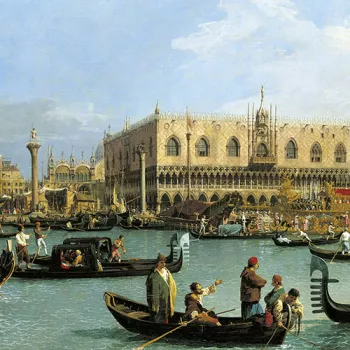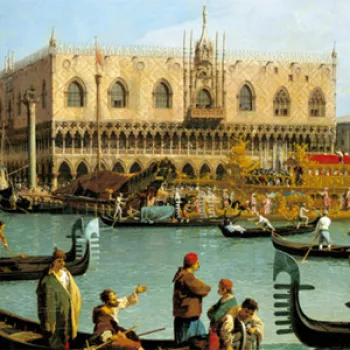The Grand Canal with Santa Maria della Salute towards the Riva degli Schiavoni c. 1729-30
Oil on canvas | 47.7 x 80 cm (support, canvas/panel/stretcher external) | RCIN 400520
-
This is one of a series of twelve views by Canaletto of the Grand Canal which are all the same format. The pictures form the basis of the fourteen engraved plates in Visentini's Prospectus Magni Canalis Venetiarum (Venice, 1735), thus providing an uncontested date for completion. It is thought that they originated in the years around 1730. The paintings were all acquired by George III with the collection of Consul Smith.
Santa Maria della Salute ('of health') was built in thanksgiving for the cessation of the plague of 1630-31, which killed almost 50,000 Venetians. As with the Redentore built the previous century following an equally devastating epidemic, the Doge processed to the church annually across a pontoon bridge to attend a commemorative service, in this case held on 21 November, the day of the Feast of the Presentation of the Virgin. The church was the masterpiece of Baldassare Longhena, built on a central plan with a huge dome over the crossing and a subsidiary dome over the great sanctuary; it was consecrated in 1687, five years after the architect's death. On the far side of the church is the Seminario Patriarcale, also by Longhena, its sober façade standing in contrast to the exuberance of the church. On the horizon are the
This view is ostensibly taken from high up in the corner of the abbey of San Giorgio, looking across the Rio della Salute to the Bacino. Canaletto has radically corrected the perspective of the church - the drum and dome should be seen strongly foreshortened from below (as in a dramatic version of the composition in the Louvre, now generally attributed to Michele Marieschi). Canaletto has also eliminated the buildings immediately across the Grand Canal from the Salute, bringing the complex around San Marco much closer to the viewer and showing the Libreria and the column with the lion, neither of which is visible from this viewpoint.
This painting is so close in style and subject matter to The Mouth of the Grand Canal looking West towards the Carità (RCIN 400519) that they must have been conceived as pendants, painted at the same time. They herald Canaletto's mature style, with liquid paint manipulated with a brush, and incising used to create the architectural detail of the Salute caught in the afternoon light.
Unlike the earlier paintings in the series, Canaletto here used a range of tones to pick out the architectural details: the church's dark recesses and foreground boats are precisely defined in black but the architectural detail beyond is created with subtle greys and browns, suggesting the nuances of Venice's atmosphere.
Adapted from Canaletto & the Art of Venice, London, 2017.Provenance
Acquired in 1762 by George III from Joseph Smith, British Consul in Venice (Italian List nos 65-76); recorded in the Gallery at Kew in 1805 (no 9)
-
Medium and techniques
Oil on canvas
Measurements
47.7 x 80 cm (support, canvas/panel/stretcher external)
67.0 x 99.5 x 9.8 cm (frame, external)
Category
Object type(s)
Other number(s)
Alternative title(s)
The Grand Canal with S. Maria della Salute towards the Riva degli Schiavoni











